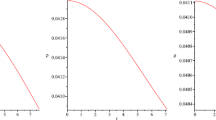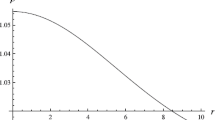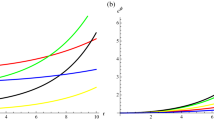Abstract
In this paper, we study the spherically symmetric anisotropic compact stars of emending class one in f(T) (where T being the torsion of the spacetime) gravity. For this purpose, we have used a particular form of the metric functions to solve the modified equation of motion in f(T) gravity for static anisotropic fluid source. The constructed models represent the class of anisotropic stars like \(SAX J 1808.4-3658 (SS1)\), \(Her X - 1, Vela X-12, PSR J1614-2230\) and \(Cen X -3\). We have calculated the physical parameters of the stars such as pressure, density, regularity and anisotropy. We have also discussed the stability of formulated models and proved that in f(T) theory of gravity (with diagonal tetrad) these models of the stars are unstable.
Similar content being viewed by others
Avoid common mistakes on your manuscript.
1 Introduction
The current cosmological observations (Riess et al. 1998; Perlmutter et al. 1999; Bennett et al. 2003) demonstrate that our universe encounters the phase of accelerated expansion. In spite of the fact that the very easy approach to clarify this fact is the inclusion of a cosmological constant (Peebles and Ratra 2003), but the challenges like fine-tuning issue connected with cosmological constant have drawn the attention of some authors to consider more realistic choices to handle the issue of expansion of the universe. Among all the possible choices, one is to discuss the dark energy paradigm, which can be originated from various fields, such as a scalar field (Ratra and Peebles 1988; Wetterich 1988) and a phantom field. A second heading is to modify the theory of gravity, such as f(R) (R is Ricci scalar) (Sotiriou and Faraoni 2010; De Felice and Tsujikawa 2010), higher derivatives in the activity (Nojiri and Odintsov 2005), brane world augmentations (Cai et al. 2006), string theory (Tsujikawa 2010), holographic properties (Hsu 2004; Li 2004; Huang and Li 2004; Ito 2005), UV modifications (Horava 2009; Calcagni 2009; Kiritsis and Kofinas 2009; Lu et al. 2009; Saridakis 2010) and so forth. As of late, another technique showen up in the literature (Ferraro and Fiorini 2007; Bengochea and Ferraro 2009; Linder 2010) is f(T) gravity. It depends on the old thought of the teleparallelequivalent of General Relativity (TEGR) (Hayashi and Shirafuji 1979, 1982; Myrzakulov 2011), which instead of utilizing the curvature can be defined via the Levi-Civita connection, with Weitzenböck connection that is free of curvature, and just depends on torsion (Caldwell 2002; Feng et al. 2005; Einstein 1928). As depicted in (Myrzakulov 2011) the Lagrangian density can then be developed from this torsion tensor under the presumptions of invariance under general coordinate transformations, global Lorentz transformations and the parity operation, along with requiring the Lagrangian density to be second order in the torsion tensor.
As compared to f(R) gravity with fourth-order nonlinear differential equations, f(T) theory of gravity has second-order field equations. This fact has enhanced the interest among the researchers to study the accelerated expansion of the universe (Bengochea and Ferraro 2009; Linder 2010) and one can reproduce a cosmological phenomena (Dent et al. 2011; Yerzhanov et al. unpublished) that include a scalar field (Wu and Yu 2010a) and constrain the model parameters (Wu and Yu 2010b) to investigate the dynamical behavior of the universe (Myrzakulov 2011). A lot of work (Jamil et al. 2012a, b, c, d, 2013a; Bamba et al. 2013; Jamil et al. 2013b; Yesmkhanova et al. 2012; Houndjo et al. 2012, 2015 Chattopadhyay et al. 2014; Rudra et al. 2012; Momeni et al. 2015; Aslam et al. 2013; Rodrigues et al. 2013; Momeni and Myrzakulov 2014) related to cosmological attractor solutions, cosmological models, reconstruction and entropy corrections in f(T) gravity has been done.
Currently, the study of compact stars and massive objects has become the subject of keen interest in general relativity as well as in modified theories of gravity (Abbas et al. 2014, 2015b, c, d, e; Zubair et al. 2016a, b; Zubair and Abbas 2016a, b; Yousaf et al. 2016a, b; Yousaf and Bhatti 2016). The astrophysical compact objects having small radii and large densities may produce very strong gravitational effects in their surrounding. In this present article, we have formulated the equations of motion for static anisotropic emending class one compact object in f(T) theory. We have investigated the physical behavior of the compact objects in the framework of f(T) gravity.
We have arranged the paper as follows: Sect. 2 investigates the matter components and equation of state parameters. The regularity conditions, anisotropic parameter and stability of the compact stars are presented in Sect. 3. Finally, we discuss the results of the paper in the last section.
2 Equations of Motion in Generalized Telleparallel Gravity
We begin with static spherically symmetric spacetime which is given by
We take the matter as anisotropic fluid for which energy-momentum tensor is
where \(u^{\mu }\) and \(v^{\mu }\) are the four-velocity and radial-four vectors, respectively. Further, \(p_r\) and \(p_t\) are pressures along radial and transverse directions.
The tetrad matrix for metric (1) is
Also, \(e=det[e_{\mu }^{i}]=e^{\frac{(a+b)}{2}}r^{2}sin(\theta )\), and using the results of (Abbas et al. 2015a), we get
where the prime means differentiations with respect to r. The modified field equations (Abbas et al. 2015a) for fluid source are
Also, Eq. (9) yields
where \(\beta \) and \({\beta }_{1}\) are integration constants; the solutions are new if \(\beta \ne 1\) and \({\beta }_{1}\ne 0\); otherwise, solutions corresponds to GR. We take the following form of metric function Karmarkar (1948); Tolman (1939):
where B, C and F are arbitrary constants that can be determined on some physical background. Now using Eq. (11), field equations leads to
The equation of state (EOS) parameters are
3 Physical Analysis of Model
This section deals with the physical properties of the proposed model like regularity, anisotropic behavior and stability.
3.1 Anisotropic Behavior
Using Eqs. (12) and (13), we get
The above results lead to following equations:
From Fig. 6, it is clear that at \(r=0\), \(\frac{d\rho }{dr}=0,~~ \frac{dp_{r}}{dr}=0\) and \(\frac{d^{2}\rho }{dr^{2}}<0,~~\frac{d^{2}p_{r}}{ dr^{2}}<0\), while at this point \(\rho \) and \(p_{r}\) have maximum values (see Figs. 1, 2). The regularity and physical behavior of \(p_t\) in Fig. 3). Also, from Figs. 4 and 5, it is clear that \(0<\omega _{r}(r)<1\) and \(0<\omega _{t}(r)\). It is concluded that stars are composed of ordinary matter and dark energy due to the effects of f(T) term. The anisotropy in this model, i.e., \(\Delta =\frac{2}{r}(p_{t}-p_{r})\) is obtained as follows:
It is clear from the Fig. 7 that for our model \(\Delta >0\) a repulsive force is present which allows the formation of super massive star.
3.2 Matching Conditions
Here, we discuss the matching of spacetime (1) to the vacuum exterior metric given by
The matching conditions at \(r=R\) yield the following results (Bhar et al. 2016):
The above equations can be simplified to the following form
For the values of M and R for a given star, the constants B, C and F can be specified as in Table 1.
3.3 Stability
In our anisotropic model, we define sound speeds as
The above equations lead to
By using the cracking concept (introduced by Herrera (1992)) we found that the region where \({\upsilon _{sr}}>\upsilon _{st}\upsilon_{sr}>\upsilon _{st}\) is potentially stable; otherwise, unstable. In present case, Fig. 8 indicates that there is no change of sign for the term \(\upsilon _{st}^{2}-\upsilon _{sr}^{2}\) within the interior of star, so proposed models are unstable.
4 Summary
This paper deals with the modeling of spherical compact stars of emending class one in f(T) gravity with diagonal tetrad field. In this case, the assumption of diagonal tetrad field leads to linear form of function f(T) in T from the equations of motion. In order to solve the field equations analytically, we have assumed the particular form of the metric components, which is compatible with the stars of embedding class one. This form of the metric functions involves some unknown constants which can be determined by matching the interior fluid source with the vacuum exterior solution. This matching is smooth as in both geometries metric tensor components are continuous. Further, both the theories, standard GR and modified f(T) theory, have equations of motion upto second order so both are compatible for smooth matching of interior and exterior solutions. We apply the observed masses and radii of some compact stars in order to determine the constant in the metric potential functions.
Further, we have investigated the explicit expression for matter density and pressure components as given in Eqs. (12)–(13). It is clear from the expression of metric functions that these are regular at \(r=0\); further density as well as pressures is non-singular at \(r=0\) shown in Figs. 1, 2, 3. The EOS \({\omega }_r\) and \({\omega }_t\) are less than one and greater than one (see Figs. 4, 5), which indicates that matter has been modified from ordinary to exotic form. Figure 6 implies the maximality of radial pressure at center \(r=0\). The anisotropic parameter \( \Delta \) is positive (as shown in Fig. 7) at all points inside the star that explains the repulsive behavior of force and plays a key role to produce more mass of the stars. We have presented the stability of the compact as given in Fig. 8; this figure shows that our proposed strange star models are unstable. This work can be extended by using the non-trivial tetrad and electromagnetic field explicitly.
References
Abbas G, Nazeer S, Meraj MA (2014) Cylindrically symmetric models of anisotropic compact stars. Astrophys Space Sci 354:449
Abbas G, Kanwal A, Zubair M (2015a) Anisotropic compact stars in f(T) gravity. Astrophys Space Sci 357:109
Abbas G et al (2015b) Anisotropic compact stars in f(G) gravity. Astrophys Space Sci 357:158
Abbas G, Qaisar S, Meraj MA (2015c) Anisotropic strange quintessence stars in f(T) gravity. Astrophys Space Sci 357:156
Abbas G, Qaisar S, Jawad A (2015d) Strange stars in f(T) gravity with MIT bag model. Astrophys Space Sci 359:67
Abbas G, Zubair M, Mustafa G (2015e) Anisotropic strange quintessence stars in f(R) gravity. Astrophys Space Sci 358:26
Aslam A, Jamil M, Momeni D, Myrzakulov R (2013) Noether gauge symmetry of modified teleparallel gravity minimally coupled with a canonical scalar field. Can J Phys 91:93
Bamba K, Jamil M, Momeni D, Myrzakulov R (2013) Generalized second law of thermodynamics in f(T) gravity with entropy corrections. Astrophys Space Sci 344:259
Bengochea GR, Ferraro R (2009) Dark torsion as the cosmic speed-up. Phys Rev D 79:124019
Bennett CL et al (2003) First year Wilkinson Anisotropy Probe (WMAP) observations: preliminary maps and basic results. Astrophys J Suppl 148:1
Bhar P, Maurya SK, Gupta YK, Manna T (2016) Modelling of anisotropic compact stars of embedding class one. Eur Phys J A 52:312
Cai RG, Gong YG, Wang B (2006) Super-acceleration on the brane through energy flow from the bulk. JCAP 0603:006
Calcagni G (2009) Cosmology of the Lifshitz universe. JHEP 0909:112
Caldwell RR (2002) A phantom menace? Cosmological consequences of a dark energy component with super-negative equation of state. Phys Lett B 545:23
Chattopadhyay S, Jawad A, Momeni D, Myrzakulov R (2014) Pilgrim dark energy in f(T, T G) cosmology. Astrophys Space Sci 353:279
De Felice A, Tsujikawa S (2010) f(R) theories. Living Rev Relativity 13:03
Dent JB, Dutta S, Saridakis EN (2011) f(T) gravity mimicking dynamical dark energy. Background and perturbation analysis. JCAP 1101:009
Einstein A (1928) Sitz Preuss. Akad Wiss p 217.
Feng B, Wang XL, Zhang XM (2005) Dark energy constraints from the cosmic age and supernova. Phys Lett B 607:35
Ferraro R, Fiorini F (2007) Modified teleparallel gravity: inflation without an inflaton. Phys Rev D 75:084031
Hayashi K, Shirafuji T (1979) New general relativity. Phys Rev D 19:3524
Hayashi K, Shirafuji T (1982) Addendum to new general relativity. Phys Rev D 19:3524
Herrera L (1992) Cracking of self-gravitating compact objects. Phys Lett A 165:206
Horava P (2009) Quantum gravity at a Lifshitz point. Phys Rev D 79:084008
Houndjo MJS, Momeni D, Myrzakulov R (2012) Cylindrical solutions in modified f(T) gravity. Int J Mod Phys D 21:1250093
Houndjo MJS, Momeni D, Myrzakulov R, Rodrigues ME (2015) Evaporation phenomena in f(T) gravity. Can J Phys 93:377
Hsu SDH (2004) Entropy bounds and dark energy. Phys Lett B 594:13
Huang QG, Li M (2004) The Holographic dark energy in a non-flat universe. JCAP 0408:013
Ito M (2005) Holographic-dark-energy model with non-minimal coupling. Europhys Lett 71:712
Jamil M, Momeni D, Myrzakulov R (2012a) Attractor solutions in f(T) cosmology. Eur Phys J C 72:1959
Jamil M, Momeni D, Myrzakulov R (2012b) Stability of a non-minimally conformally coupled scalar field in F(T) cosmology. Eur Phys J C 72:2075
Jamil M, Momeni D, Myrzakulov R (2013c) Observational constraints on non-minimally coupled Galileon model. Eur Phys J C 73:2267
Jamil M, Momeni D, Myrzakulov R (2012d) Resolution of dark matter problem in f(T) gravity. Eur Phys J C 72:2122
Jamil M, Momeni D, Myrzakulov R (2012e) Noether symmetry of F(T) cosmology with quintessence and phantom scalar fields. Eur Phys J C 72:2137
Jamil M, Momeni D, Myrzakulov R (2013) Energy conditions in generalized teleparallel gravity models. Gen Relativ Gravit 45:263
Jamil M, Yesmkhanova K, Momeni D, Myrzakulov R (2012) Phase space analysis of interacting dark energy in F(T) cosmology. Cent Eur J Phys 10:1065
Jamil M, Momeni D, Myrzakulov R, Rudra P (2012) Statefinder analysis of f(T) cosmology. J Phys Soc Jp 81:114004
Jamil M, Momeni D, Myrzakulov R (2015) Warm intermediate inflation in F(T) gravity. Int J Theor Phys 54:1098
Karmarkar KR (1948) Gravitational metrics of spherical symmetry and class one. Proc Ind Acad Sci A 27:56
Kiritsis E, Kofinas G (2009) Horava-Lifshitz Cosmology. Nucl Phys B 821:467
Li M (2004) A model of holographic dark energy. Phys Lett B 603:1
Linder EV (2010) Einstein's other gravity and the acceleration of the universe. Phys Rev D 81:127301
Lu H, Mei J, Pope CN (2009) Solutions to Horava gravity. Phys Rev Lett 103:091301
Momeni D, Myrzakulov R (2014) Cosmological reconstruction of f(T, T) gravity. Int J Geom Method Mod Phys D 11:1450077
Myrzakulov (2011) Accelerating universe from F(T) gravity. Eur Phys J C 71:1752
Nojiri S, Odintsov SD (2005) Modified Gauss-Bonnet theory as gravitational alternative for dark energy. Phys Lett B 631:1
Peebles PJ, Ratra B (2003) The cosmological constant and dark energy. Rev Mod Phys 75:559
Perlmutter S et al (1999) Supernova cosmology project collaboration. Astrophys J 517:565
Ratra B, Peebles PJE (1988) Cosmological consequences of a rolling homogeneous scalar field. Phys Rev D 37:3406
Riess AG et al (1998) Supernova search team collaboration. Astron J 116:1009
Rodrigues ME, Houndjo MJS, Momeni D, Myrzakulov R (2013) Planer symmetry in f(T) gravity. Int J Mod Phys D 22:1350043
Saridakis EN (2010) Hořava–Lifshitz dark energy. Eur Phys J C 67:229
Sotiriou TP, Faraoni V (2010) f(R) theories of gravity. Rev Mod Phys 82:451
Tolman RC (1939) Static solutions of Einstein's field equations for spheres of fluid. Phys Rev 55:364
Tsujikawa S (2011) Dark energy: investigations and modeling. In: Matarrese S, Colpi M, Gorini V, Moschella U (eds) Dark matter and dark energy. A challenge for modern cosmology. Astrophysics and space science library, vol 370. Springer, Netherlands, pp 331–402
Wetterich C (1988) Cosmology and the fate of dilatation symmetry. Nucl Phys B 302:668
Wu P, Yu H (2010a) The dynamical behavior of f(T) theory. Phys Lett B 692:176
Wu P, Yu H (2010b) Observational constraints on f(T) theory. Phys Lett B 693:415
Yerzhanov KK, Myrzakul SR, Kulnazarov II, Myrzakulov R. Accelerating cosmology in F(T) gravity with scalar field. arXiv:1006.3879 (unpublished)
Yousaf Z, Bamba K, Bhatti MZ (2016a) Causes of irregular energy density in f (R, T) gravity. Phys Rev D 93:124048
Yousaf Z, Bamba K, Bhatti MZ (2016b) The influence of modification of gravity on the dynamics of radiating spherical fluids. Phys Rev D 93:064059
Yousaf Z, Bhatti MZ (2016) Stability of compact stars in αR2 + βQ gravity. Mon Not Roy Astron Soc 458:1785
Zubair M, Abbas G (2016a) Some interior models of compact stars in f(R) gravity. Astrophys Space Sci 361:342
Zubair M, Abbas G (2016b) Analytic models of anisotropic strange stars in f(T) gravity using off diagonal tetrad. Astrophys Space Sci 361:27
Zubair M, Abbas G, Noureen I (2016a) Possible formation of compact stars in f(R, T) gravity. Astrophys Space Sci 361:8
Zubair M, Sardar IH, Rahaman F, Abbas G (2016b) Interior solutions of fluid sphere in f(R,T) gravity admitting conformal killing vectors. Astrophys Space Sci 361:238
Author information
Authors and Affiliations
Corresponding author
Rights and permissions
About this article
Cite this article
Abbas, G., Qaisar, S., Javed, W. et al. Compact Stars of Emending Class One in f(T) Gravity. Iran J Sci Technol Trans Sci 42, 1659–1668 (2018). https://doi.org/10.1007/s40995-016-0144-2
Received:
Accepted:
Published:
Issue Date:
DOI: https://doi.org/10.1007/s40995-016-0144-2












